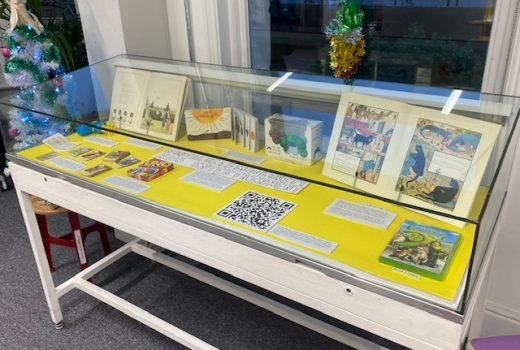
BA History of Art and Visual Culture students Tiffany Barron, Poppy Phelps, Olivia Heim Romero and Alfie Mancell announce their new exhibition, now on display at St Peters House Library
What memories do you have as a child? Perhaps reading a book before bed, or playing a card game with your family at Christmas time? These early childhood memories of game playing are the focus of our exhibition ‘Kids’ Entertainment – Nostalgia and Modernity’.
Bringing together items from both past and present, the exhibition aims to explore the change in childhood across a time period between the early 1800s until present day. With focus on games, nursery rhymes and books, we hope to communicate the relatively quick change that has occurred over the past 200 years. With the rise of social media, quick delivery times and speedy trend cycles, early childhood has never been more changeable. Hours spent playing board games have been replaced.
Items have been chosen in pairs in order to highlight this contrast. The modern card game UNO sits alongside the 1950’s Faraway Tree with the aim of highlighting the change of pace in card games. Having UNO accessible to play for general public adds an element of participation to allow viewers to become more engaged with the topic. Similarly, the 1969 book The Hungry Caterpillar is accompanied by its 2000’s counterpart in the form of a stuffed animal depicting the main character the Caterpillar himself. These are just a few examples of the items that are being used to create the point of the exhibition.

J.C. Sowerby and H.H. Emmerson, ‘Afternoon Tea’, London, Frederick Warne and Co, from the St Peters House Library Collection
In creating this exhibition it was also important to make it accessible for its target audience. Given the option between two university locations, it was important to choose a location that was both physically accessible and had a lot of foot fall. For that reason, the University of Brighton’s St Peters House Library was selected for its central city location and disability access.
Being located in the foyer of the University of Brighton’s St Peters House Library, we knew that our target audience would most likely be students and academic professionals. Looking at that group, the majority of our target age range would sit within their late teens and twenties. Taking this into account, it was felt that it would be useful to incorporate social media into the exhibition.
Social media is a key element in changing childhood experiences. Parents often use iPads as tools for both education and distraction in today’s modern age, an extreme change from the early 1800s and even from the early 2000s when members of the exhibition team were growing up. In having social media as part of the exhibition highlights the speed at which resources are accessible. Not only does it relate to the topic but it also makes the exhibition more accessible to those who cannot be there or struggle with reading small text labels. Through the use of QR codes attached to the items, viewers will be able to access more in-depth explanations and histories of the items should they so wish. This also means that the viewer could alter the text size on their phone should sight be an issue.
